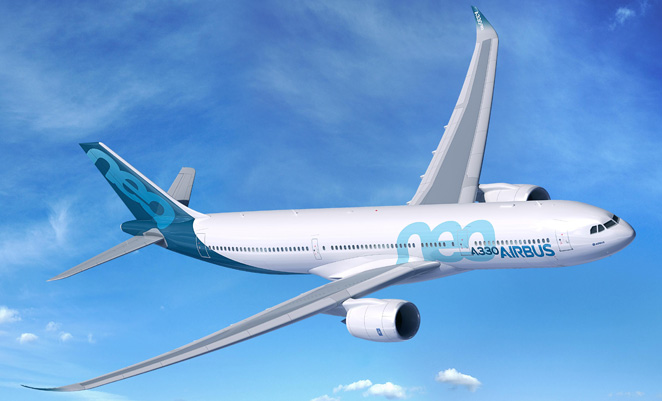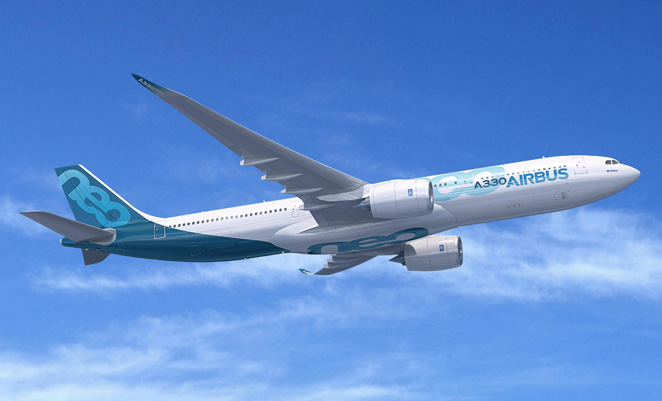
Airbus has used the 2014 Farnborough Airshow to formally announce the launch of a re-engined version of its best-selling A330 range.
Dubbed A330-800neo and A330-900neo, the new aircraft will be significantly enhanced versions of the current A330-200 short fuselage and longer -300 models respectively. They will be powered exclusively by new Rolls-Royce Trent 7000 engines, and feature aerodynamic enhancements including curved wingtips similar to those of the A350, and new cabin features, and will offer a reduction in fuel consumption of 14 per cent over the current models.

“We see strong market potential for the A330neo, and like its market-leading smaller sister, the A320neo, we are confident this new aircraft will be a success in the medium-haul segment,” said Fabrice Brégier, Airbus president and CEO. “We are again leveraging a proven aircraft with a wide operator base and making it even more efficient with the latest innovations and technology developments.”
Kiran Rao, Airbus’s Executive VP, strategy and marketing, claims the A330neo will offer lower cash operating costs than Boeing’s 787.
“The A330neo delivers a 14 per cent improvement in fuel per seat. Fourteen per cent improvement will make us as efficient as today’s 787,” Rao said. “If we couple that with the lower maintenance costs and the higher passenger count of the A330 we have an airplane that will deliver lower cash operating costs than that of the 787 and lets not talk about price. But I can tell you that if we put everything together we will have a much better proposition to the airlines than the 787 has.”
Rao also promotes the passenger comfort benefits of the A330neo.
“Every passenger in economy class has an 18in seat, that is much more than you get in an 787. So if we take the cabin, you take the improvements that we will give to the lighting, the improvements we will give to the side-walls and the larger overhead bins, we will improve the crew rest areas for the pilots and cockpit crew … put all that together and we will deliver an airplane where the passenger is the real winner.”
However, unlike the largely carbon fibre composite 787, the A330neo retains the A330’s conventional aluminium fuselage design, and so won’t offer the 787’s larger windows, humidity and cabin pressure altitude advantages.
Rolls-Royce says its new 68-72,000lb thrust class Trent 7000 will account for 10 per cent of the A330neo’s fuel burn improvements. It says that “first engine test run for the Trent 7000 is planned for 2015 with certification expected in 2017, supporting an aircraft entry into service in Q4 2017,” and that the “engine design draws upon existing architectures and expertise”.
Ironically, the specifications of the A330neo are very similar to those laid out for the original A350 of almost a decade ago but which was subsequently rejected by the market due to a perceived technical superiority of Boeing’s 787. Several follow-on iterations of the A350 resulted in the A350XWB which is currently in flight test and which is due to enter service later this year with Qatar Airways.
But in the face of significant delays to the 787 program and airlines expressing a preference for the larger A350-900 and 787-9 models of the new airliners, Airbus evidently sees an opportunity in the lower end of the market for an airliner, the development of which has largely been amortised in recent years, and which could slot in below the more expensive high-tech A350 and 787 ranges both in capacity and in price.
It will also be interesting to see if Airbus proceeds with the smaller A350-800 model which will go up against the A330neo range as well as the 787-8 in the 200-300 seat market. The A350-800 was originally intended to be the second model in the A350 range to enter service, but was deferred in the face of greater airline interest in the -900 and stretched -1000 models.
The A330neo will certainly be built on successful foundations. To date Airbus has sold over 1,300 A330s to nearly 100 customers worldwide, with Qantas, Jetstar and Virgin Australia operating the type locally.
“The A330 is a very important margin contributor for our Group. It’s also one of the most reliable and efficient commercial aircraft ever,” Airbus Group CEO Tom Enders said. “Customers love it. With our decision to re-engine the plane, we will keep the A330 flying high for many more years to come. The development costs for the A330neo will be incurred from 2015 to 2017 with an impact of around -70 basis points on Airbus Group’s 2015 Return on Sales target. However, we have a very good business case and the A330neo, once in service, will continue to significantly contribute to our group’s earnings.”
















Sagara Wirasinha
says:whats the final distance to cover that this is expecting , in nautical miles with a full MTOW.
Peter
says:Potentially an excellent aircraft & my guess is that the list price will be at least 10% less than competing aircraft making it a sound business proposition & an ideal upgrade for the many operators of the current A330ceo as well as A340’s.
billy
says:Let’s unpack this Airbus hype: 1) comfort.Most airline orders are from AirAsiaX which plans a nine across configuration with 16.5″ seat width. The 9 across is the only config that brings efficiency close the 787. And it still is less efficient. 2) Efficiency improvements after the reengine are limited exactly because this is a “mature” model. The 787 has alot more improvement room in efficiency because the model can evolve more. The 787s advantage may be small now but will continue to grow.3) Price will improve as well with new production techniques on the 787..more potential than future improvements on the mature optimized a330neo. Overtime the 787 will be cheaper for the lifetime of the aicraft. The A330neo is less comfortable, less fuel efficient and the gap will grow, and overtime the A330neo will be more expensive over the life of the aircraft..By the way,Airbus does not make comparisons with the 787-10, this is the true competitor with the A330neo-900 and is by far the most efficient of the 787 series.